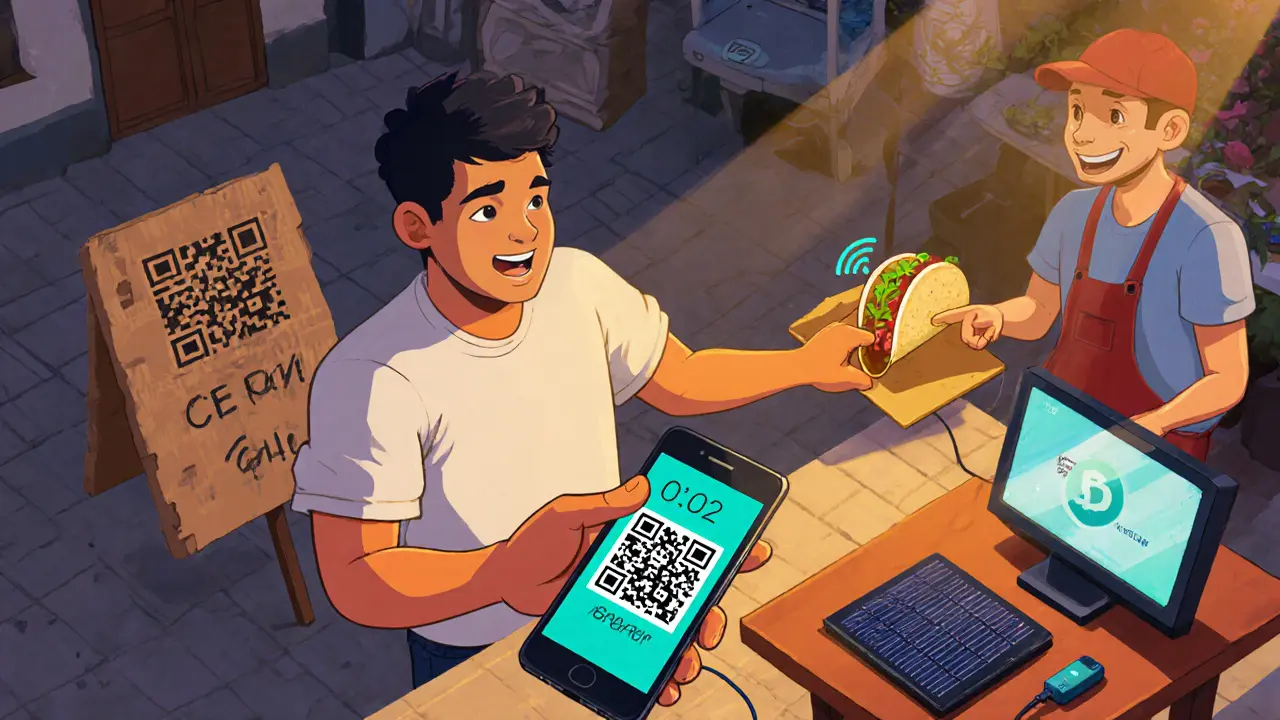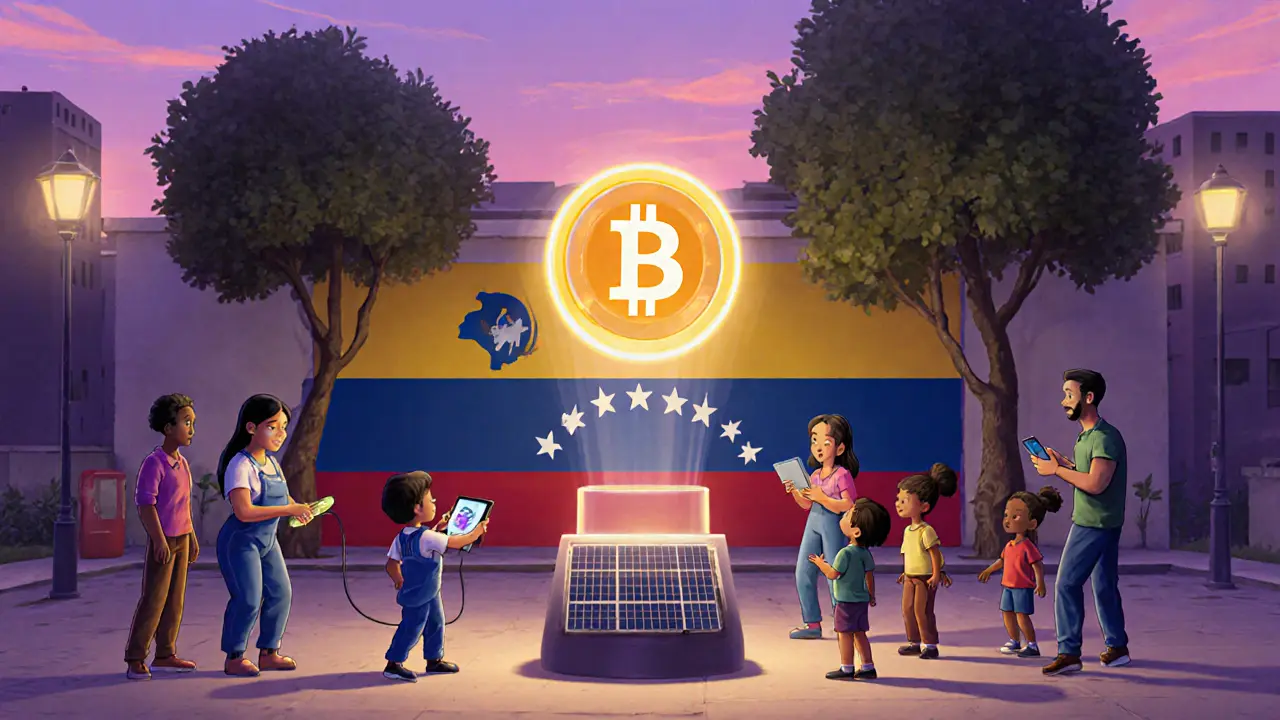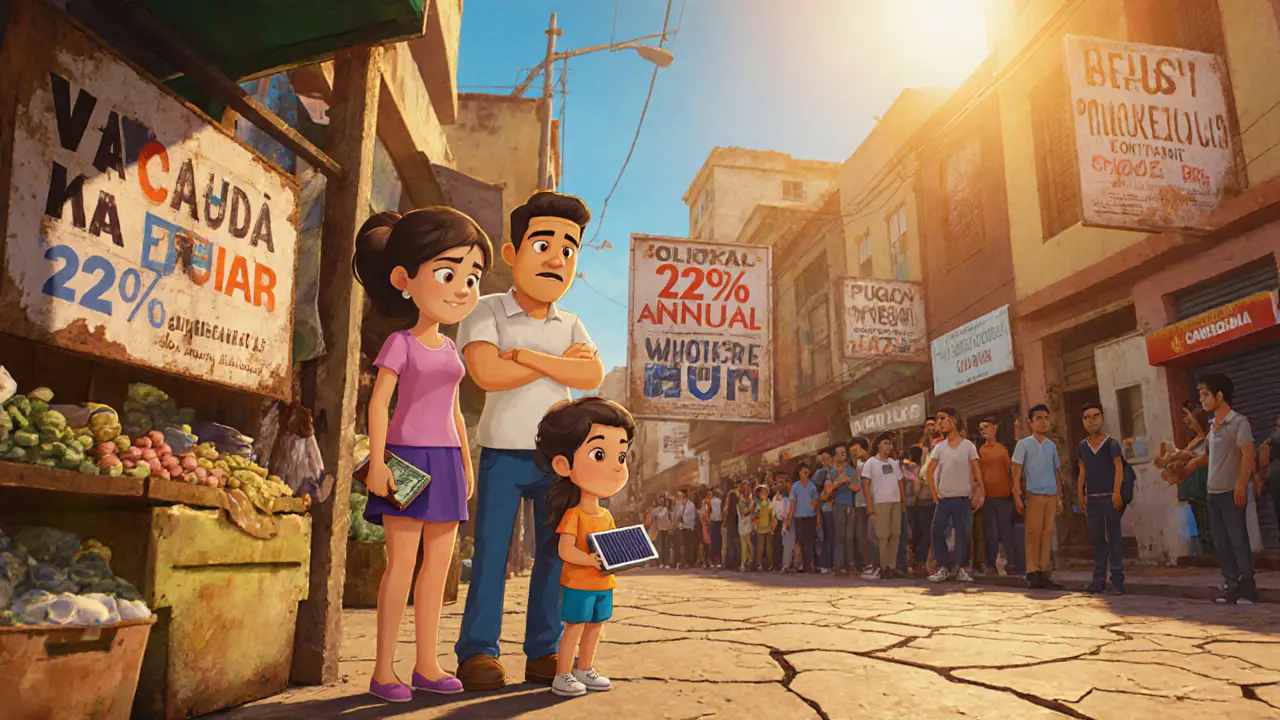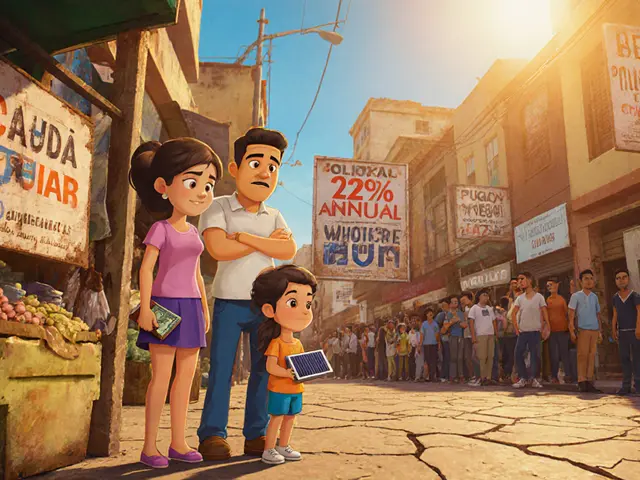Venezuelan Currency Value Calculator
Convert Bolívar to Cryptocurrency
See how your bolívar value translates to stablecoins and Bitcoin during hyperinflation
USDT Equivalent
(~$0.02 per transaction)
Bitcoin Equivalent
(~$2-5 per transaction)
What can you buy?
This amount would buy 0 cups of coffee ($1.00 USDT each)
Important Note: The current exchange rate between bolívar and crypto is based on the black-market dollar rate ("dólar negro") which is not fixed. Our calculator uses an approximate conversion rate.
When the Venezuelan economy spirals under hyperinflation, Venezuelan cryptocurrency usage refers to the everyday reliance on digital assets like Bitcoin and stablecoins to preserve purchasing power and conduct transactions has become a lifeline for millions.
Hyperinflation: The Economic Backdrop
By May2025 the annual inflation rate hit 229% and month‑on‑month inflation hovered around 26%. The bolívar lost more than 70% of its value since early 2025, making it almost impossible to keep a wage intact between payday and grocery checkout. Traditional banking channels are clogged with sanctions, and cash withdrawals are rationed. In this environment, any store of value that can move quickly and retain price is instantly attractive.
Why Cryptocurrency Became the Go‑To Tool
Cryptos solve three core problems that the bolívar cannot:
- Speed: Peer‑to‑peer transfers settle in minutes, versus days for bank wires.
- Borderless access: Remittances from abroad can bypass a crippled financial system.
- Store of value: A dollar‑pegged stablecoin holds purchasing power while Bitcoin offers a hedge against currency collapse.
For most citizens crypto isn’t an investment gamble; it’s a daily budgeting tool. As Carlos from Caracas says, “I use USDT for everything - buying food, paying rent. It is much more reliable than the bolívar.”
Dominant Coins and Platforms
The market has coalesced around a few key assets and services. The first mention of each includes microdata for future reference.
Bitcoin (BTC) the original cryptocurrency, used by vendors who accept QR‑code payments on mobile wallets remains popular for larger purchases and as a hedge against long‑term devaluation.
USDT (Tether) a dollar‑backed stablecoin, primarily on the TRC‑20 network for cheap transactions dominates everyday micro‑payments. Locals call it “Binance Dollars” because most swaps happen on the Binance P2P marketplace.
Binance a global crypto exchange that offers a peer‑to‑peer marketplace tailored to the Venezuelan market provides the most liquid outlet for converting bolívars into USDT and vice‑versa.
LocalBitcoins a P2P platform where users meet in person or via chat to trade BTC and USDT serves as the backup network when Binance access is restricted.
The state‑backed Petro, launched in 2018, was officially retired in 2024 after failing to gain trust. Its brief existence still appears in legacy discussions, so we’ll keep it in the comparison table for historical context.

How Everyday Transactions Work
Most Venezuelans follow a three‑step routine:
- Acquire USDT or BTC: Users buy on Binance P2P using cash, a prepaid debit card, or a gift‑card code. Prices are set by the community’s own “P2P rate,” which typically tracks the black‑market dollar (the “dólar negro”).
- Store on a mobile wallet: Lightweight apps like Trust Wallet or the Binance app keep private keys on the phone. No high‑end hardware is needed.
- Pay merchants: Street vendors scan a QR code, sending the exact USDT amount. Larger shops display prices in both bolívars and USDT, often with a line like “Precio en Binance dollars: 1.02USDT”.
Remittances follow a similar path: relatives abroad buy USDT on international exchanges, send the address to the recipient, who then converts the stablecoin into cash at a local meet‑up or via a prepaid card.
Technical Hurdles and Community Workarounds
Power outages and spotty internet are the norm. To stay online, users keep a small solar charger and rely on Wi‑Fi hotspots in cafés. When connectivity drops, many pre‑load QR codes for common amounts, allowing a merchant to accept a payment without real‑time network confirmation (the transaction is later broadcast when the phone reconnects).
Security is a growing concern. Because most users are new to private‑key management, community groups on Telegram and Facebook run “key‑safety” workshops, teaching people to back up seed phrases on paper stored in a safe place.
Bank restrictions force creative cash‑out methods: prepaid Visa‑type cards bought with USDT, cash meet‑ups in public squares, and even gift‑card swaps for Amazon or Netflix credits that can later be sold for bolívars.
Comparison of Crypto Options in Venezuela
| Asset | Primary Use | Network Fees (USD) | Stability | Regulatory Risk |
|---|---|---|---|---|
| USDT (TRC‑20) | Everyday purchases, remittances | ~0.01‑0.03 | 1:1 USD peg (subject to issuer risk) | High - subject to U.S. sanctions on Tether |
| Bitcoin (BTC) | Store of value, larger payments | ~2‑5 (depends on network congestion) | Volatile, but historically outpaces inflation | Medium - widely regulated but not banned |
| Petro | Government propaganda, limited actual use | ~0.10 (legacy network) | Low - tied to oil price, no market depth | Very high - sanctions and public distrust |
USDT’s cheap fees and dollar peg make it the clear choice for buying a cup of coffee, while Bitcoin’s scarcity protects savings from the hyperinflation spiral. The Petro, once touted as a national digital currency, now sits on the sidelines.

Risks, Limitations, and the Road Ahead
Crypto solves short‑term liquidity but cannot fix the structural problems that caused the crisis. Analysts point out three long‑term risks:
- Regulatory crackdowns: The government has intermittently shut down mining farms and warned exchanges, creating uncertainty for users.
- Stablecoin centralization: USDT’s reliance on a single issuer means a sanction could freeze access for millions.
- Infrastructure fragility: Power and internet outages limit how reliably a digital wallet can be used.
Nevertheless, the trend toward “blockchain‑based dollarization” appears irreversible. As the bolívar continues to lose purchasing power, more people will learn to navigate peer‑to‑peer platforms, and market actors are already building low‑bandwidth wallet solutions tailored to Venezuela’s reality.
What to Watch in 2026 and Beyond
Four signals will shape the next wave of crypto adoption:
- Improved solar‑powered devices: Local manufacturers are rolling out affordable solar chargers, extending wallet uptime.
- Emergence of community‑run stablecoins: Projects that issue a Venezuelan‑dollar‑backed token on a decentralized network could bypass U.S. sanction risk.
- Policy shifts after the 2025 elections: If a new government softens sanctions, formal crypto exchanges might gain legal footing.
- Integration with remittance corridors: Partnerships between diaspora groups and local fintech startups could streamline inbound crypto flows.
For now, the daily reality remains simple: people scan a QR code, send a few USDT, and walk away with a meal that would otherwise be unaffordable in bolívars.
Frequently Asked Questions
How do I buy USDT in Venezuela?
The most common route is through Binance’s peer‑to‑peer marketplace. You create an offer, set the price in bolívars or dólares negros, and meet the buyer in a public place to exchange cash for USDT transferred to your wallet.
Can I use Bitcoin to pay at street vendors?
Yes. Many vendors have installed QR‑code scanners that generate a Bitcoin address. The transaction is confirmed within minutes, and the vendor often converts the BTC to USDT instantly via a local P2P service.
What are the fees for sending USDT on the TRC‑20 network?
TRC‑20 fees are among the cheapest, typically ranging from $0.01 to $0.03 per transaction, regardless of amount.
Is the Petro still usable?
The Petro was officially discontinued in 2024. A few underground traders still hold it, but it lacks liquidity and is not accepted by mainstream merchants.
What security steps should I take with my crypto wallet?
Write down the seed phrase on paper, store it in a safe place, enable two‑factor authentication on any exchange account, and never share your private key via messaging apps.


Comments
The hyperinflation in Venezuela has forced a grassroots migration toward decentralized finance. By leveraging stablecoins like USDT, citizens can sidestep the volatile bolívar and preserve purchasing power. It’s a classic case of financial inclusion via blockchain, where the network effect lowers transaction friction. Of course, the black‑market dollar rate adds an extra layer of complexity, but the community‑driven exchanges keep the flow alive. In short, crypto is becoming the de‑facto hedge for daily transactions.
One must question whether the allure of speculative assets truly mitigates the systemic erosion of trust in a nation‑state’s monetary policy. While crypto promises anonymity, it also veils opacity, allowing new vectors of abuse. The Venezuelan populace, already strained, may be swapping one precarious store of value for another. Nevertheless, the ingenuity displayed is commendable, even if it skirts conventional regulatory safeguards.
From a moral perspective, the recourse to digital currencies may be seen as a necessary evil, yet it does not absolve the governing bodies from their fiduciary responsibilities. The stark reality of hyperinflation forces citizens into a digital bargain, albeit fraught with risk. It is, however, a testament to human resilience in the face of economic collapse. Please note the unintended paterns of reliance on unstable market dynamics.
Interesting how the calculator translates bolívar amounts into coffee‑sized units of crypto. It gives a tangible sense of what a few bucks can actually buy when the local currency is worth a fraction of a cent. The integration of black‑market rates makes the tool grounded in reality, even if it highlights how far off official figures are. This kind of transparency can empower everyday users to make smarter financial choices.
Oh great, another shiny coin to lose your lunch money on. Welcome to the circus.
When you examine the Venezuelan experience with cryptocurrency, a multi‑layered narrative emerges. First, the acute devaluation of the bolívar erodes the basic function of money: a reliable medium of exchange. Second, citizens, driven by necessity, gravitate toward assets that can retain value across borders. Stablecoins such as USDT provide a peg to the U.S. dollar, which, despite the black‑market premium, offers a more stable reference point than the local currency. Third, the infrastructure-mobile wallets, peer‑to‑peer platforms, and informal exchange networks-has organically evolved to bypass traditional banking constraints. Fourth, transaction costs, while seemingly high on paper, become negligible when juxtaposed with the daily loss incurred from hyperinflation. Fifth, the social fabric adapts: vendors start quoting prices in crypto, families hold savings in digital wallets, and remittances flow through blockchain bridges. Sixth, regulatory ambiguity persists; the state oscillates between tolerance, outright bans, and opportunistic taxation. Seventh, this liminal space fosters a unique form of financial literacy, where users must understand gas fees, wallet security, and exchange rate volatility. Eighth, the psychological impact is profound; hope resurfaces when a digital token can purchase a loaf of bread. Ninth, the macro‑economic indicators shift subtly, as informal crypto circulation introduces a parallel monetary system. Tenth, external observers note that this could serve as a model for other economies facing similar crises. Eleventh, the sustainability of such a system hinges on continued access to internet connectivity and the resilience of blockchain networks. Twelfth, any major disruption-whether a new sanctions regime or a blockchain fork-could reverberate through daily life. Thirteenth, community‑driven education initiatives have sprung up, teaching users how to safeguard private keys. Fourteenth, the convergence of crypto with local traditions creates a hybrid cultural economy. Finally, while challenges remain, the Venezuelan case illustrates how technology can fill gaps left by failing institutions, offering a pragmatic, if imperfect, toolkit for survival.
Wow, that was a marathon of insight! Reading through those 15‑plus sentences feels like watching a documentary on crypto resilience. It’s both heartbreaking and inspiring to see people turn to digital assets as a lifeline. Your breakdown really captures the gritty reality on the ground.
From a technical standpoint, the integration of black‑market rates into the calculator is a clever workaround, albeit a messy one. It mirrors the real‑world frictions users face, and honestly, that’s where the rubber meets the road. If you’re looking to optimize transaction fees, keep an eye on network congestion; sometimes a simple layer‑2 solution can shave off a few dollars.
So cool to see a tool that actually translates bolívar into coffee‑sized crypto slices! ☕️🚀 It gives hope that even a tiny amount can buy something real. Keep the updates coming, folks! 👍
Great addition! This kind of practical calculator demystifies crypto for everyday users. It’s a helpful bridge between abstract finance and real‑world buying power. Keep it up! :)
Honestly, this whole crypto‑thing is just a distraction from the real issue: the government's reckless monetary policy. While people scramble for stablecoins, the state continues to print bolívars like there's no tomorrow. Patriotism means demanding accountability, not hiding behind anonymous wallets.
Obvious.
One could argue that the pursuit of stablecoins reflects a deeper philosophical yearning for certainty in a world of flux. Yet, uncertainty remains an inherent condition of existence, crypto or not.
It is evident that the Venezuelan population has adopted a pragmatic approach to preserving value. The deployment of decentralized assets illustrates both ingenuity and resilience in the face of systemic monetary decay.
From an analytical perspective, the data shows a clear correlation between bolívar depreciation and stablecoin adoption rates. This trend underscores the necessity for alternative financial instruments when sovereign currency policies fail.
another tool… another reminder that we can’t trust anything official anymore. guess we just roll with it.
Let’s acknowledge the bravery of everyday Venezuelans who navigate this volatile landscape. Their adaptability is a reminder that technology, when placed in the right hands, can empower communities during crises.
While the ingenuity is commendable, we must not overlook the moral implications of normalizing unregulated financial ecosystems. Such systems can inadvertently shelter illicit activities under the guise of necessity.
Consider the epistemological dimensions of this shift: when a population redefines value outside traditional fiat, it challenges longstanding economic dogma. Yet, practical constraints often force a compromise between idealism and survival.
It’s clear that the crypto usage in Venezuela is not just a fad, but a response to real economic pressures. My personal take is that thiswill shape future policy discussions in ways we cant fully predict yet.
the tool is usefull but some of the numbers look off maybe check the exchange api again?
just thinking about how the everyday shopper now has to juggle bolívars, USDT, and Bitcoin to get a soda. crazy times.
Whoa, drama alert! If we’re all supposed to become crypto‑savvy saints, someone hand me a crystal ball and a Wi‑Fi router. The saga continues, and the popcorn is metaphorical. 🎬